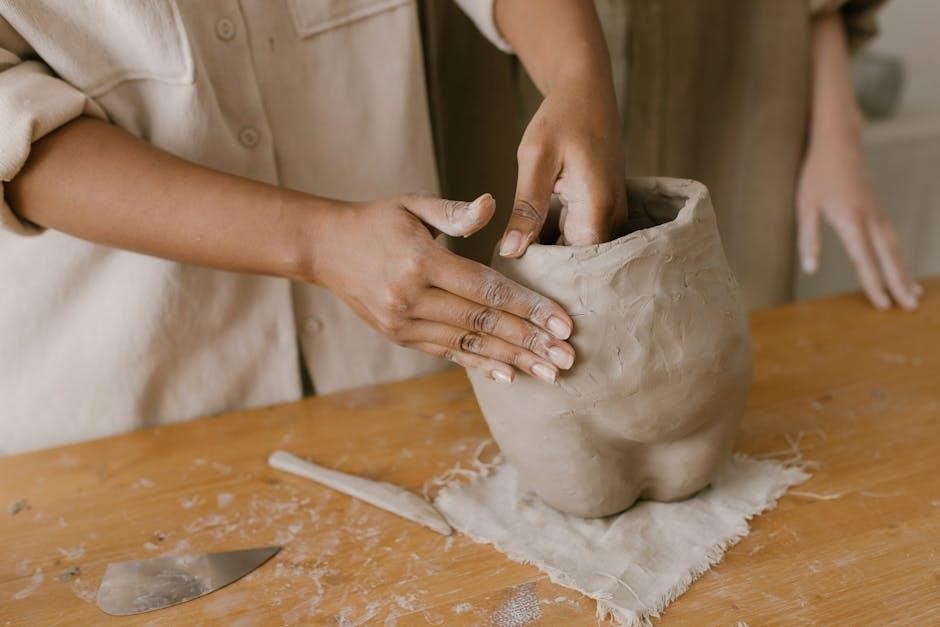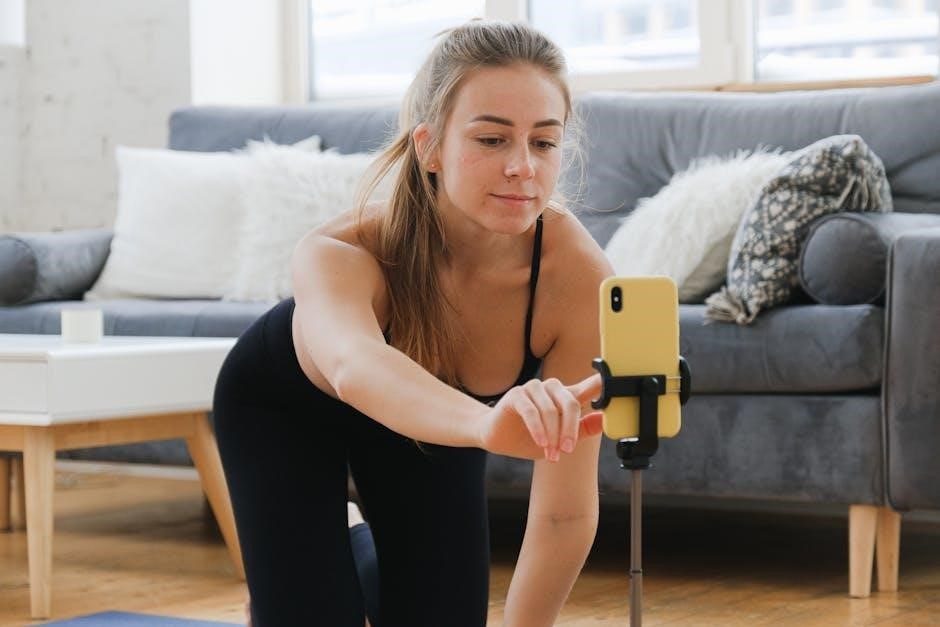Selfbondage is a form of BDSM practice involving self-restraint for personal exploration, empowerment, or pleasure. It combines physical restraint with mental discipline, requiring careful planning and safety measures.
What is Selfbondage?
Selfbondage is a consensual BDSM practice where individuals restrain themselves using ropes, cuffs, or other tools. It involves creating a safe, controlled environment to explore physical and psychological sensations. Unlike traditional bondage, selfbondage relies on personal discipline and preparation. The practice can serve various purposes, including personal growth, stress relief, or sexual gratification. It requires careful planning, knowledge of techniques, and awareness of risks to ensure a safe and enjoyable experience. Selfbondage is not about pain but about mastery and self-discovery.
Why People Practice Selfbondage
People engage in selfbondage for various reasons, including personal empowerment, stress relief, and sexual exploration. It allows individuals to explore their limits, fostering self-awareness and resilience. Some find it meditative, as it requires focus and mindfulness. Others enjoy the thrill of surrendering control or the satisfaction of overcoming challenges. Selfbondage can also enhance intimacy with oneself or a partner, offering a unique way to connect with one’s body and desires. Ultimately, it’s a journey of self-discovery and growth, tailored to personal preferences and boundaries. Empowerment and fulfillment are central to this practice.

Safety Considerations
Selfbondage requires careful planning and awareness of physical limits to ensure safety. Proper techniques, emergency preparedness, and education are essential for a secure and enjoyable experience.
Understanding Risks and Precautions
Selfbondage carries inherent risks, including circulation issues, nerve damage, and panic. Understanding these risks is crucial for safe practice. Proper precautions, such as using high-quality materials, planning escape routes, and setting time limits, can minimize dangers. It’s essential to assess physical and mental limits beforehand; Aftercare is also vital to ensure emotional and physical well-being post-session. Always prioritize safety and seek professional guidance if unsure.
Essential Safety Tools and Equipment
Key safety tools include high-quality restraints like wrist and ankle cuffs, sturdy rope, and quick-release mechanisms. A first aid kit is crucial for emergencies. Always have emergency scissors or a knife within reach. Use a backup key for padlocks and consider a time-release mechanism. Ensure all materials are durable and non-constricting. A mobile phone nearby is vital for calling help if needed. Proper tools help prevent accidents and ensure a safe selfbondage experience. Never compromise on quality or accessibility of safety equipment.

Materials and Preparation
Common materials include ropes, cuffs, and restraints. Prepare by ensuring all items are clean, durable, and properly tested. Organize your space to access tools easily during sessions.
Common Materials Used in Selfbondage
Common materials include ropes (cotton, nylon, or hemp), cuffs (leather or metal), and gags. Soft restraints like silk ties or bondage straps are also popular. Other items include blindfolds, spreader bars, and chains. DIY materials like scarves or belts can work, but purpose-made gear is safer and more durable. Always prioritize quality to avoid breakage or injury.
Preparing Your Environment for Selfbondage
To ensure a safe and enjoyable experience, clear your space of tripping hazards and fragile objects. Use cushions or pillows for comfort. Anchor points should be sturdy and secure. Keep emergency tools, like scissors or keys, within easy reach. Have water nearby for hydration, especially during prolonged sessions. A mirror can help monitor your position. Ensure good ventilation and a stable temperature. Familiarize yourself with your setup beforehand to avoid panic. A well-prepared environment enhances safety and confidence.

Basic Selfbondage Techniques
Basic selfbondage techniques focus on simple, safe restraint methods. These include foundational knots, wrist and ankle ties, and body positioning. Always prioritize comfort and accessibility for quick release.
Simple Knots and Restraints
Mastering simple knots and restraints is fundamental to selfbondage. The square knot and clove hitch are essential for securing limbs without causing harm. Wrist and ankle ties are basic, while body harnesses offer full immobilization. Always ensure restraints are snug but not overly tight to avoid circulation issues. Practice tying knots on loose fabric before applying them to your body. Start with easy-to-release knots and gradually explore more complex ones as confidence grows. Safety and comfort should always guide your technique.
Step-by-Step Guide to a Basic Selfbondage Setup
Begin by gathering materials like soft ropes, safety scissors, and a timer; Choose a quiet, obstacle-free space and ensure easy access to tools. Start by securing one wrist to a stable object using a simple knot, then repeat for the other limb. Gradually incorporate ankle restraints, connecting them to the wrists or another anchor. Use a quick-release mechanism for emergencies and set a timer for added control. Test mobility and circulation before finalizing the setup, ensuring comfort and safety.

Advanced Selfbondage Methods
Advanced techniques involve complex knots, multi-point restraints, and time-release mechanisms. These methods require precision, patience, and extensive practice to ensure safety and desired outcomes.
Using Time-Release Mechanisms
Time-release mechanisms add an element of unpredictability to selfbondage, allowing restraints to be released automatically after a set period. Common methods include using timers, ice, or slow-burning materials. These techniques require precise planning to ensure safety and reliability. They enhance the psychological aspect of selfbondage, creating a thrilling mix of anticipation and surrender. Always test mechanisms beforehand and have backup release tools available to avoid emergencies.
Incorporating Gags and Sensory Deprivation
In selfbondage, gags and sensory deprivation enhance the experience by heightening focus and intensifying sensations. Gags can muffle sound, adding an element of power dynamics, while blindfolds or earplugs reduce visual or auditory input. Use breathable materials like silk or cotton for comfort and safety. Start with short sessions to build tolerance. These techniques amplify psychological responses, creating a deeper sense of vulnerability and immersion. Always ensure quick-release mechanisms are in place and prioritize aftercare to process emotions.

Managing Risks and Emergencies
Managing risks and emergencies in selfbondage requires preparation. Always have safety tools like scissors or keys within reach. Plan for unexpected situations to ensure quick, safe release. Stay calm and prioritize your well-being.
How to Safely Release Yourself
To safely release yourself, always have a reliable tool, like safety scissors or a release key, within easy reach. Stay calm and methodically locate your restraints. If using ropes, gently unwind them or cut them with scissors. For locks, use your key or a spare. If using time-release mechanisms, wait patiently for the designated time. After release, check for any discomfort or injury and address it immediately. Practice these steps beforehand to build confidence and ensure smooth execution.
Dealing with Accidents or Complications
If an accident occurs, remain calm and prioritize your safety. Assess the situation and use your safety tools, such as a knife or spare key, to release yourself. If unable to free yourself, call for help or use a prearranged signal. After resolving the issue, inspect for injuries and seek medical attention if necessary. Reflect on what went wrong to prevent future incidents. Always have a first-aid kit nearby and consider sharing your practices with a trusted partner for added security.

Psychological and Emotional Aspects
Selfbondage engages both mind and body, fostering empowerment and personal growth. It requires mental discipline, emotional resilience, and self-awareness, which enhances understanding of limits and desires.
Mental Preparation and Mindset
Mental preparation is crucial for selfbondage, requiring focus, self-awareness, and a clear intention. Understanding personal limits and embracing vulnerability builds confidence and resilience. Emotional resilience helps navigate challenges, fostering a mindset of trust in oneself and the process. Practicing breathing techniques and visualization can enhance calmness and control. Self-compassion is essential, as is maintaining a positive outlook. A prepared mindset ensures a meaningful and empowering experience, both physically and emotionally.
Aftercare and Emotional Well-being
Aftercare is essential for emotional and physical recovery post-selfbondage. It involves checking for injuries, rehydrating, and providing self-compassion. Acknowledge your feelings, whether euphoria or vulnerability. Engage in comforting activities like warm baths or journaling to process emotions. Patience and kindness toward yourself are vital. Reflection helps integrate the experience, fostering growth and understanding. Remember, aftercare is personal—tailor it to your needs. If emotions feel overwhelming, consider reaching out to a trusted friend or professional for support.
Selfbondage is a journey requiring patience, dedication, and self-awareness. Always prioritize safety and proper preparation. Embrace the experience with curiosity and enjoy the personal growth it offers.
In this selfbondage tutorial, we explored the fundamentals of self-restraint, emphasizing safety, preparation, and mental readiness. Key points include understanding risks, using appropriate materials, and mastering basic knots. Advanced techniques like time-release mechanisms and sensory deprivation were also covered. Psychological aspects, such as mindset and aftercare, are crucial for a positive experience. Always prioritize safety, use reliable tools, and plan for emergencies. Remember, selfbondage is a personal journey that requires patience, learning, and responsible practice.
Encouragement for Further Exploration
Exploring selfbondage is a deeply personal and rewarding journey. Embrace curiosity and patience as you discover new techniques and experiences. Remember, growth comes from practice and learning. Connect with communities, seek resources, and celebrate your progress. Every step forward is a testament to your courage and dedication. Keep exploring, and let your journey be guided by safety, self-awareness, and a passion for discovery.
